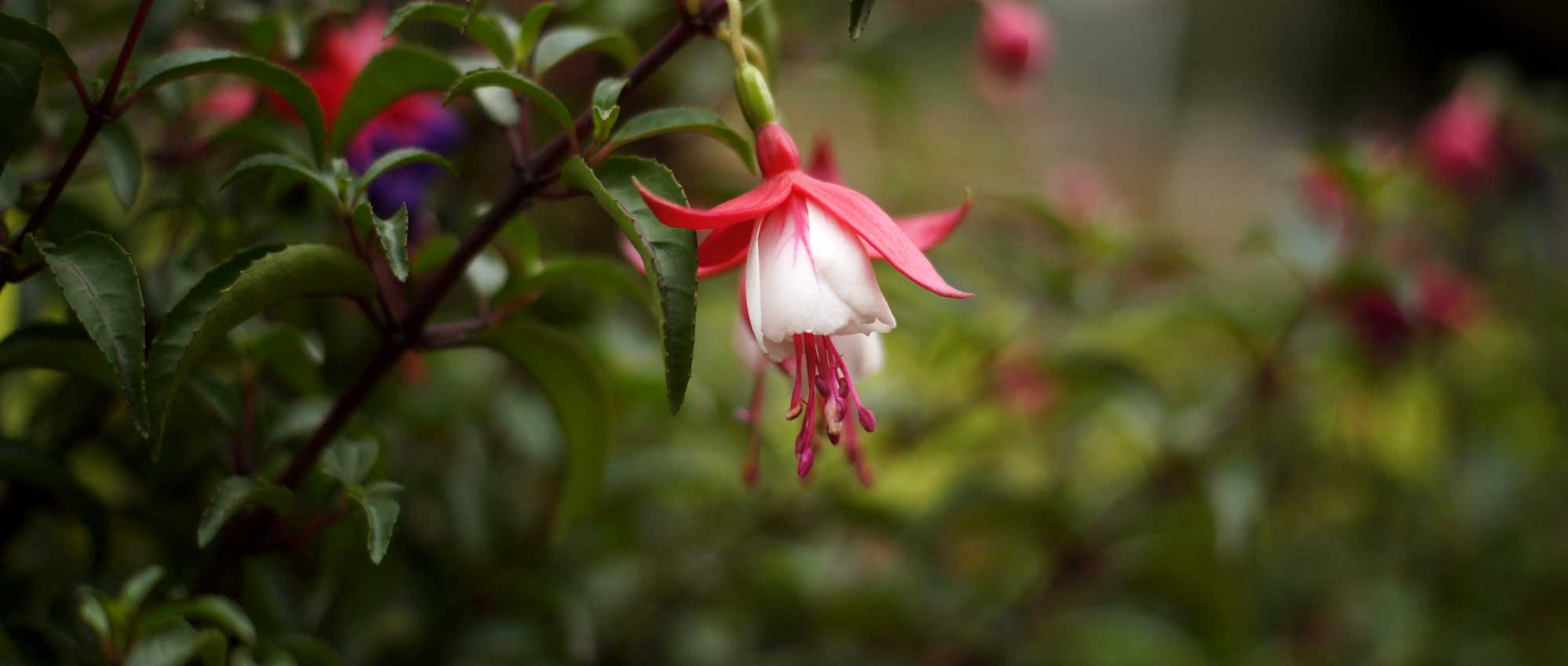
Fuchsia: planting, pruning, culture and maintenance
Contents
Fuchsias in a nutshell
- Fuchsias offer a generous and long summer flowering period, from June until the frosts!
- They are appreciated for their trailing bell-shaped flowers, generally in shades of red, pink, purple, and white.
- They thrive in partial shade, protected from cold winds, in fresh, well-draining soil.
- Most are tender plants, but there are also some hardy varieties!
- Trailing varieties are perfect for hanging baskets.
A word from our Expert
Fuchsias are plants that offer a lovely flowering display from early summer until the frosts. The flowers form pendulous bells on the branches and come in stunning colours, often red, pink, purple, or white. They are usually bicoloured. Some fuchsias bear double flowers, with numerous petals. From the simplest forms to the most extravagant, fuchsias provide a beautiful diversity of flowerings! In most varieties, the foliage is green, but there are also fuchsias with variegated leaves, such as Fuchsia magellanica ‘Versicolor’.
Fuchsias are known to be somewhat tender, however, some varieties are quite resistant to cold, such as Fuchsia magellanica, ‘Alice Hoffman’, ‘Blue Sarah’, ‘Tom Thumb’, etc. Fuchsias can take various forms: they can be bushy, trailing, or even climbing! They therefore adapt to different uses in the garden (beds, hedges, pergolas, hanging…).
Fuchsia planting takes place in spring. As they do not like scorching sun or dense shade, it is best to place them in a partially shaded location. They generally need to be protected from the cold in winter. If you are growing them in pots, simply bring them under cover to protect them from frost. It is advisable to carry out pruning in autumn.
Description and Botany
Botanical data
- Latin name Fuchsia sp.
- Family Onagraceae
- Common name Fuchsia
- Flowering from June until frost
- Height between 30 cm and 4 m
- Sun exposure preferably semi-shade.
- Soil type cool, draining, humus-bearing
- Hardiness often low, but some varieties tolerate down to -15 °C
The fuchsias represent around 110 species, mainly shrubs and small trees, most of which are native to Central and South America, but there are also a few species from New Zealand and Tahiti. Fuchsias are primarily tropical or subtropical plants. In the wild, they are found in forests or forest edges, in mountainous regions. There are epiphytic fuchsias that, in their natural habitat, grow directly on the branches of trees. Fuchsias are popular garden plants due to their unique and colourful flowering, with small bells hanging from the stems. They have been heavily hybridised, and there are several thousand horticultural varieties. The Magellan fuchsia, along with the varieties derived from it, is one of the most well-known and cultivated.
It was the botanist and explorer Charles Plumier who discovered this plant in the 17th century during his third expedition to the Antilles. He particularly noted Fuchsia triphylla, which he found in 1696-1697 in the Dominican Republic. He named it fuchsia in honour of the German botanist and physician Leonhart Fuchs (1501 – 1566). The first species of Fuchsia were introduced into English greenhouses and gardens at the end of the 18th century.
The fuchsia belongs to the family Onagraceae (around 830 species). These are herbaceous or shrubby plants, some of which are cultivated in gardens: epilobes, gaura, evening primroses… As well as Ludwigia, or jussies, aquatic plants that multiply very quickly and sometimes invade wet areas. The Zauschneria californica, known as California Fuchsia, is a plant very close to the fuchsia, also belonging to this family. However, the Phygelius capensis, or Cape Fuchsia, also resembles the fuchsia but is quite distantly related.

Fuchsia discolor: botanical illustration
Fuchsias are generally small shrubs, but some species can form true trees in the wild! When planted in gardens in France, fuchsias often remain quite compact, as their aerial parts (stems, branches, leaves…) struggle to survive the winter. The plant regrows from the stump in spring if it is hardy enough. However, fuchsias are sometimes cultivated as annual plants and replanted each spring. When grown in pots, their lack of hardiness is not really a problem, as they can simply be brought indoors for the winter. Some fuchsias are, however, quite hardy: this is the case for Fuchsia magellanica and some other varieties.
Fuchsias are fast-growing plants. They can take on a wide variety of forms, being upright, but also creeping or even trailing, which makes them very decorative in hanging displays. There are even climbing varieties (for example, ‘Lady Boothby’). The Fuchsia regia ‘Reitzii’ is a climbing plant that can be trained against a wall or directed onto a pergola. Finally, fuchsias can also be grown as standards (a very straight trunk ending in a rounded tuft of leaves).
The height of fuchsias varies greatly: the smallest measure around 30 cm in height, while the largest (like Fuchsia boliviana) can reach up to 4 metres. The Fuchsia excorticata forms a true tree that can reach 12 metres in height in its native habitat!
Fuchsias are appreciated for their long and generous summer flowering, which usually occurs from June until frost.
Fuchsia flowers often have two bright colours. The contrast is stunning, making the flowers truly vibrant and luminous. In many varieties, the sepals are pink and the petals are purple. It is, of course, the fuchsia that gave its name to this colour. Flowering generally comes in shades of pink – red – purple – white. Flowers can also be blue, as in the variety ‘Blue Sarah’, and there are also varieties with orange flowers. The flowers are very light, almost white, in Fuchsia magellanica var. molinae.
Fuchsia flowers are slender and elongated, bell-shaped, hanging from the branches by a long peduncle. They consist of four rather slender sepals surrounding four much wider and rounder petals. The sepals are coloured and resemble petals closely. They are fused into a long tube, opening at the end, taking on a spreading silhouette. The flowers have eight stamens, accompanied by a style that protrudes from the corolla tube and extends well beyond it. Their colours, often pink or red, harmonise well with the rest of the flower. Sometimes, the calyx tube is really long, as in Fuchsia triphylla and Fuchsia boliviana, giving the flower a very elongated silhouette. Conversely, some fuchsias have very rounded flowers, like Fuchsia ‘Garden News’. Flowers can also be double, with several rows of petals.

The flowering of fuchsias. From left to right, Fuchsia ‘Blue Sarah’, Fuchsia boliviana, Fuchsia ‘Winston Churchill’ and Fuchsia procumbens (photo Dominicus Johannes Bergsma)
Fuchsia flowers evoke dancers, with the petals forming the skirt, the stamens and pistils as the legs; while the calyx tube resembles the body extending, and the sepals, when raised, look like arms. When there are many petals (double varieties), it truly resembles a frilly dress with numerous folds.
There are also fuchsias with very original flowers, such as Fuchsia excorticata, which bears waxy, purplish flowers, sometimes even on the trunk, or Fuchsia procumbens, with small yellow, green, and red flowers, lacking petals, and with the tips of the stamens being blue! In Fuchsia boliviana, the flowers are gathered in large numbers and have a very long and thin tube, giving the flowering a completely different style.
In their native region, fuchsia flowers are pollinated by hummingbirds.
The leaves of the Fuchsia are very ordinary: they are simple, undivided, oval in shape, and with a dentate margin. They are generally opposite, placed two by two on the stems, but can also be whorled (at least three leaves inserted at the same point). They can reach up to 20 cm long, but are sometimes much smaller: in Fuchsia procumbens, they are rounded and measure less than 2 cm in length.
In most varieties, the leaves are green. However, here again, fuchsias offer beautiful diversity! The Fuchsia magellanica ‘Aurea’ has stunning golden foliage, very bright. The leaves can be variegated, as in Fuchsia magellanica ‘Variegata’. There are also varieties with red leaves, such as the fuchsia ‘Burning Blush’.

The foliage of Fuchsia regia ‘Reitzii’, Fuchsia ‘Genii’ and Fuchsia ‘Tom West’
The leaves are generally deciduous, disappearing in autumn and then developing again in spring, but they can also be semi-evergreen, depending on the climate in which the plant is grown (cold temperatures causing leaf drop).
The stems and petioles of the fuchsia often take on a pinkish hue, which sometimes extends onto the main vein of the leaf.
In autumn, the fuchsia produces berries measuring between 0.5 and 2.5 cm in length, often dark purple in colour. They contain a large number of small seeds. The berries are edible but rather bland, or with an unpleasant aftertaste. Those of Fuchsia splendens are among the best, with a rather lemony and peppery taste. They can be made into jams. The variety ‘Regal’ also offers interesting fruits to consume.

The berries of Fuchsia regia ‘Reitzii’
The main varieties of fuchsia
Hardy perennial fuchsias for open ground
Most of them are hardy fuchsias that can be planted in open ground without any problem, even in the north of France. Fuchsia magellanica has a bushy habit and can be integrated into a hedge. Finally, some species in this category are climbing: Fuchsia ‘Lady Boothby’, Fuchsia regia ‘Reitzii’…
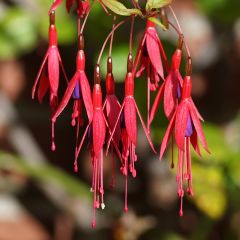
Fuchsia magellanica Riccartonii
- Flowering time August to October
- Height at maturity 1,20 m
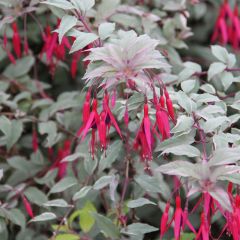
Fuchsia magellanica Versicolor
- Flowering time August to November
- Height at maturity 1 m
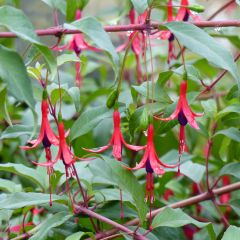
Fuchsia regia Reitzii
- Flowering time September to December
- Height at maturity 1,25 m
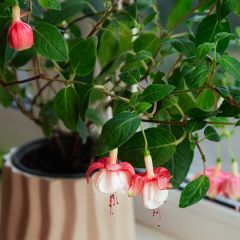
Fuchsia hybrida Alice Hoffman
- Flowering time July to November
- Height at maturity 40 cm
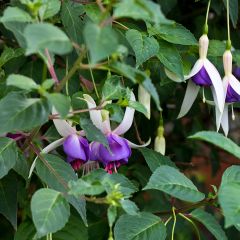
Fuchsia Blue Sarah
- Flowering time July to November
- Height at maturity 90 cm
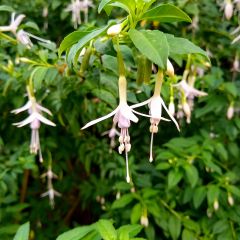
Fuchsia magellanica var. molinae
- Flowering time August to November
- Height at maturity 80 cm
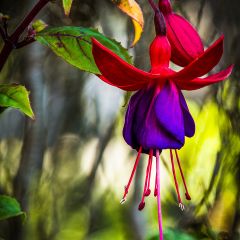
Fuchsia Lady Boothby
- Flowering time August to October
- Height at maturity 2,50 m
Fuchsias for pots and hanging baskets
They are often less hardy, but you can easily bring them indoors for the winter! These varieties are sometimes also grown as annuals and replanted each spring. For hanging baskets, we recommend choosing varieties with a trailing habit.
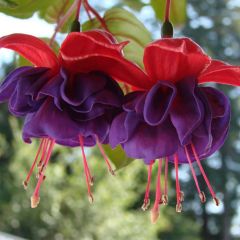
Fuchsia Dark Eyes
- Flowering time July to October
- Height at maturity 50 cm
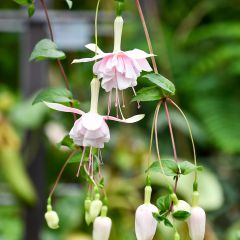
Fuchsia Holly Beauty
- Flowering time July to November
- Height at maturity 40 cm
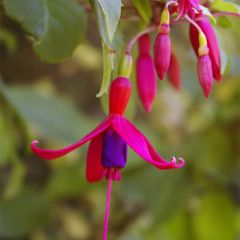
Fuchsia magellanica Genii
- Flowering time July to November
- Height at maturity 1 m
Garden Fuchsia, Hybrid Fuchsia
- Flowering time July to November
- Height at maturity 40 cm
Discover other Perennial Fuchsia
View all →Available in 1 sizes
Available in 2 sizes
Available in 1 sizes
Available in 1 sizes
Available in 2 sizes
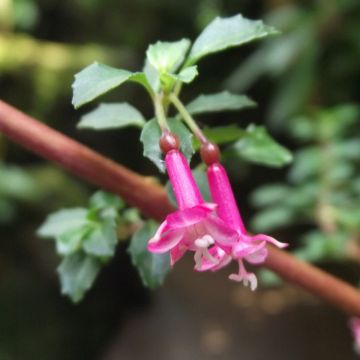
Available in 2 sizes
Available in 2 sizes
Available in 1 sizes
Available in 1 sizes
Available in 1 sizes
Planting Fuchsias
Where to plant?
Fuchsias thrive in partial shade. Ideally, they should receive morning sun and afternoon shade during the hottest hours. They tolerate shaded conditions well as long as there is sufficient light. Avoid extremes: dense shade as well as scorching sun. The exposure also depends on your geographical location: plant in the shade if you are in the south, and in the sun if you are in the north of France. Fuchsia triphylla is better suited to warm, sunny situations than other species.
Plant in well-draining soil, as fuchsias are sensitive to soils that remain wet in winter, making them more susceptible to cold and fungal diseases. Fuchsias will withstand lower temperatures better if planted in well-draining substrate rather than in waterlogged soil during winter. Similarly, to protect them, plant in a location sheltered from cold winds.
Place them in a humus-rich substrate, fertile. Fuchsias prefer light, loose, airy soils; avoid overly heavy and compacted soils. Regarding pH, they favour slightly acidic or neutral soils.
In open ground, fuchsias find their place in borders (at the back for the taller varieties) or along the edges. Some species, notably Fuchsia magellanica, can be integrated into a free-standing hedge. As for trailing or climbing varieties, they can be installed at the base of arbors, pergolas, or trellises, allowing their branches to climb these supports.
You are not obliged to plant fuchsias in open ground but can plant them in pots, for example, to enhance a terrace, balcony, or windowsill. Trailing varieties are often used in hanging displays. The less hardy fuchsias can be grown directly under a greenhouse or conservatory.
When to plant?
Plant fuchsias in spring, starting in May, after the last frosts.
How to plant?
To plant your fuchsias:
- Place the root ball in a basin filled with water.
- Work the soil deeply to ensure it is well loose and aerated.
- Dig a planting hole about three times the size of the root ball. Add well-decomposed compost, and optionally a bit of crushed horn or dried blood. Also, consider adding drainage materials if your soil is heavy (gravel, coarse sand…).
- Place your fuchsia in the ground. You can bury the collar under 5 centimetres of soil, which will help protect the plant from the cold. However, this may also encourage the development of fungal diseases.
- Fill in with soil all around, then lightly firm it down.
- Water generously.
Continue to water regularly after planting until the plant is established.
You can also plant fuchsias in pots or hanging baskets, choosing a sufficiently large container. In this case, place a drainage layer at the bottom of the pot (gravel, broken pot shards, clay balls…). Use a good potting mix that is rich and airy, light, to which you will add a bit of compost.
→ Learn more about growing Fuchsia in pots
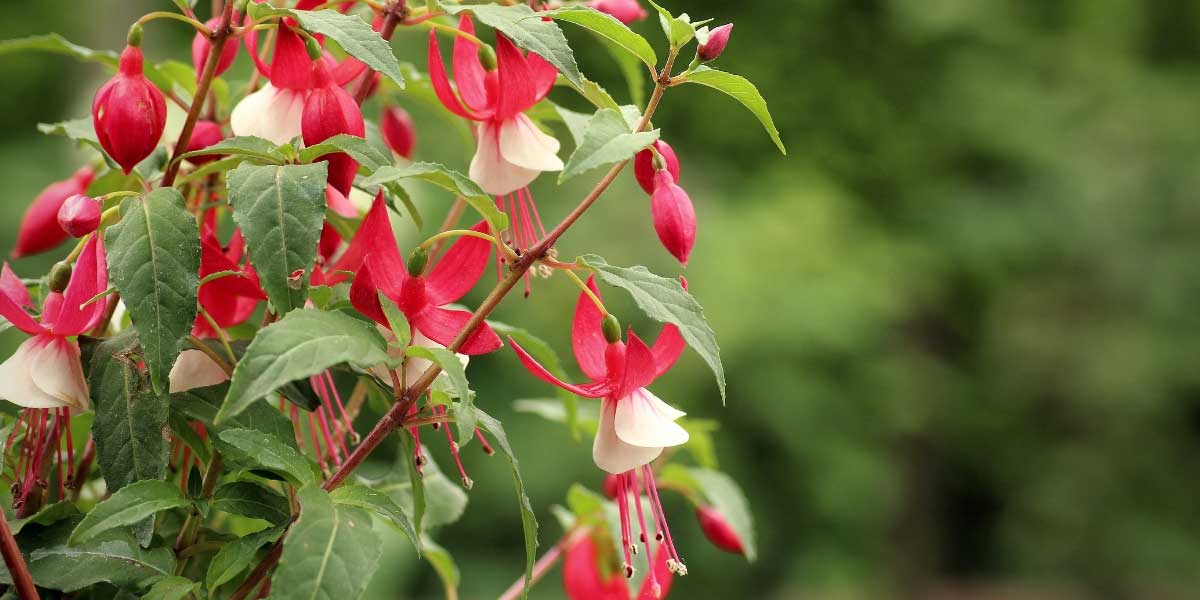
Read also
Fuchsia: how to overwinter?Maintenance, watering, protection against the cold
Remember to water from time to time to keep the soil moist… Especially if you are growing them in pots! However, water without excess, allowing the substrate to dry out between waterings to prevent the onset of fungal diseases. Avoid drowning the roots!
Fuchsias are hungry plants that appreciate rich soils and regular applications of fertiliser to support flowering. If you are growing them in pots, provide them with liquid fertiliser (such as geranium fertiliser) approximately every 15 days, especially in spring and during the flowering period. Avoid fertilisers that are too high in nitrogen, as they may limit flowering. In the ground, you can apply compost around your plants in spring, and possibly a little dried blood or ground horn, which you can incorporate into the soil with light scratching.
The fuchsia should be pruned after winter, as soon as the frost has passed, by cutting it back to half its height. We also recommend pinching the stems when the plant starts its growth (in spring), as this will encourage it to branch out and take on a more compact, attractive shape. Cut the tips of the stems manually with your nails.
It is possible to train fuchsias to give them a bush-stem shape (an upright trunk supporting a rounded tuft of foliage). They need to be staked to achieve a straight trunk, and lateral shoots should be regularly removed.
How to protect fuchsias from the cold?
Many fuchsias are not very hardy, so they generally need protection in winter.
If you have planted them in pots, cut them back to half their height, then bring them indoors around October, for example, under a veranda. You can take them back outside in spring, starting in May.
Non-hardy fuchsias can also simply be grown as annual plants. You can replant them each spring.
In the ground, cut the plant back by half and then protect the stump with a good layer of fallen leaves or straw, which you can hold in place with a winter fleece. You can remove this protection in spring. Additionally, when planting, you can bury the collar a few centimetres deep and place the plant in a sheltered spot away from the wind. Also, remember to limit watering in winter; the soil should not be waterlogged (if in a pot, place the plant in a sheltered spot away from rain).
Note that the concept of hardiness is relative, as it greatly depends on growing conditions: a fuchsia grown in wet soil or exposed to winds will be much more sensitive to cold than if it is in well-draining substrate and in a sheltered location. Similarly, fuchsias in pots left outside in winter will be more vulnerable than those in the ground. The roots close to the pot walls are at risk of freezing. Finally, fuchsias trained on stems are also more sensitive to cold than others!
Fuchsia diseases and pests
The Fuchsia can be attacked by aphids. These small insects pierce the tissues and extract the sap, which weakens the plant. To get rid of them, we recommend using black soap. The fuchsia is also sometimes affected by red spider mites, which also suck the sap. In case of an attack, spray water on the foliage, as these insects fear humidity. Beware of whiteflies, especially when the plant is grown in a greenhouse. These, like aphids, can lead to the appearance of sooty mould, a fungus that is noticeable by the appearance of a kind of black soot on the leaves.
You may also see galls develop on the fuchsia, caused by a mite native to Brazil, Aculops fuchsiae. This mite pierces the leaves, which then become covered in a white felt, resembling powdery mildew. They turn red, become deformed, and galls appear on the leaves and stems. The fight against this (invasive) mite is complicated but is obligatory. The solution is to destroy the contaminated plant by burning it.
In terms of diseases, the fuchsia is sometimes affected by fuchsia rust (Pucciniastrum epilobii), which is recognised by the appearance of yellow or brown spots on the upper side of the leaves, and orange, powdery pustules on the underside. To get rid of it, we suggest spraying a solution based on sulphur. The fuchsia can also be affected by grey mould (Botrytis), a fungal disease favoured by humidity. It is better to reduce watering or shelter the plant from rain. Remove the affected parts of the plant, then spray a fungicidal solution, for example, a horsetail decoction.
→ Read also: Diseases and pests of fuchsias
propagation by cuttings
We recommend propagating it by cuttings, a technique that is quicker and easier than sowing, and has the advantage of ensuring identical plants to the original variety.
Propagation by Cuttings
You can propagate fuchsia in spring (herbaceous cuttings, in April-May) or late summer (woody cuttings, around September).
To do this:
- Take a pot and fill it with potting soil, preferably mixed with a bit of sand or perlite to make it well-draining. Water it so that it is nicely moist.
- Take a stem, preferably not flowering. It should be about 7-8 cm long. Cut just below a node (the point where the leaves attach to the stem).
- Remove the leaves at the base, leaving only those on the upper part. Similarly, if there are any flowers, remove them.
- You may optionally dip the base of the stem in plant hormone, but this step is optional.
- Make a hole in the substrate using a small stick, then place the cutting in it.
- Firmly pack the soil around it to avoid leaving air pockets.
- We recommend placing a plastic bottle around the cutting to create a humid environment (with a high humidity level).
- Place the pot in a bright location but out of direct sunlight.
Keep the substrate well moist until the cutting starts its growth.
→ Learn more about fuchsia propagation by cuttings in our tutorial!
Associating Fuchsias in the Garden
The fuchsia is quite suitable for urban gardens, easily finding its place in sheltered spots, protected from the wind by walls. It can be installed, for example, in a pot on a terrace or in a patio, or hung to decorate a balcony. Place it near ornamental foliage plants, such as Carex, Hakonechloa, or ferns, which will beautifully highlight its flowering. You can add some flowers like agapanthus, hardy geraniums, or alliums.
With its original and vibrant flowering, the fuchsia allows for the creation of an exotic-style garden. Choose to accompany it with southern hemisphere plants, originating from places like Australia and New Zealand, South Africa, or even South America. For example, place callistemons, phormiums, yuccas, cordylines… Also discover the surprising Fascicularia bicolor. You can plant bougainvilleas, banana plants (Musa basjoo), Aspidistras, and Colocasias. Add some bright colour with kniphofias and crocosmias, whose shades will wonderfully complement those of the fuchsia!
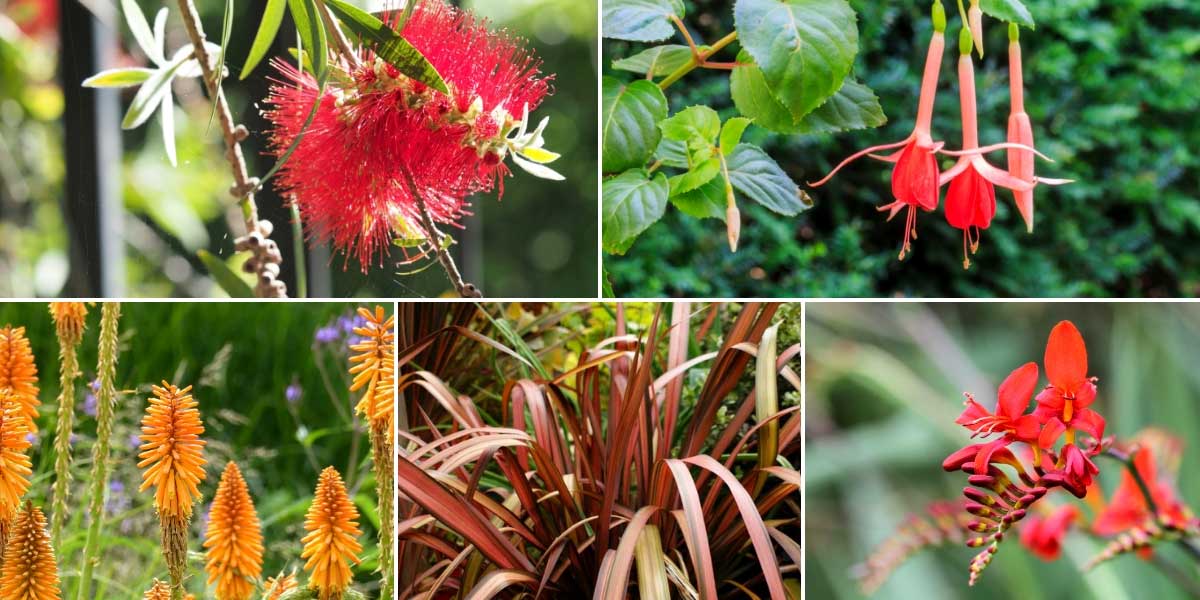
Fuchsias allow for the creation of an exotic garden, with other plants in warm tones, in shades of red and orange. Callistemon comboynensis, Fuchsia ‘Helena’ (photo Dominicus Johannes Bergsma), Kniphofia ‘Fiery Fred’, Phormium ‘Pink Panther’, and Crocosmia
Fuchsias pair very well with decorative foliage: ferns, hostas, brunneras, carex… You can create a beautiful scene in partial shade, which will nicely highlight the vibrant flowers of the fuchsias. Pair them with other perennials that enjoy shaded conditions.
With its bushy habit, Fuchsia magellanica can be planted as a hedge or garden border. You can create a rustic hedge, with a more natural style, by planting it alongside other bushes. Choose to accompany it with hydrangeas, viburnums, dogwoods, deutzias… Mix deciduous and evergreen shrubs. You can also integrate some plants with decorative berries (symphorine, callicarpa, Nandina domestica…) or with autumn-coloured foliage, for a beautiful late-season scene.
To accompany fuchsias, we recommend prioritising other plants that offer a long summer flowering, such as Gaura lindheimeri, campanulas, hardy geraniums, nepeta, Verbena bonariensis… You will enjoy a garden in full bloom throughout the summer!
→ Discover more association ideas with Fuchsia and Which fuchsias to choose for outdoor cultivation? in our advice sheets!
Useful resources
- Discover our range of Fuchsia!
- Check out our article on Fuchsia: the most beautiful varieties for hanging
- Our shrubby fuchsias
- A forum on fuchsias and their cultivation
- The website of the British Fuchsia Society (in English)
- Advice sheet: Fuchsia: how to winter it?
- Advice sheet: Fuchsia: 6 hardy species and varieties; Which fuchsias to choose for outdoor cultivation?
- Fuchsia in pots: Growing a Fuchsia in a pot; The best varieties of Fuchsia to grow in pots
- Advice sheet: How to pinch fuchsias for more flowers?
- Advice sheet: Fuchsia on a stem, pruning and maintenance
Frequently asked questions
-
Why are the leaves of my fuchsia turning yellow and falling off?
This may be due to excess moisture. Check if the soil is wet, and if so, space out your watering more. You can also move (repot if it is in a pot) the plant into a slightly more draining substrate. Conversely, if your plant is lacking water, its foliage may dry out, turn yellow, and fall off. Check the condition of the soil! Otherwise, if you notice this problem in autumn, it is normal: fuchsia is a deciduous plant, and it naturally loses its leaves when temperatures drop. Also, check if the conditions are suitable: is the plant placed in the right spot, in partial shade, in a draining and sufficiently rich substrate? Don't hesitate to add a bit of fertiliser.
-
My fuchsia is not flowering, or flowering very little, why?
The sparse flowering of a fuchsia can be explained by an excess of nitrogen fertiliser, which promotes foliage at the expense of flowers. Depending on its location, it may also be lacking in light. If you have planted it in the shade, do not hesitate to move it to a spot where it can benefit from filtered sunlight, such as morning sun. The flowering of fuchsias is more generous when they receive a bit of sun. Finally, excess moisture can also hinder flowering.
-
The leaves of my fuchsia have yellow or orange spots.
It is likely affected by fuchsia rust (Pucciniastrum epilobii), a disease caused by a fungus. We recommend spraying a sulphur-based solution on the foliage.
-
The leaves are distorted and covered with a grey veil.
This is likely fuchsia gall, caused by a mite, Aculops fuchsiae. If you see galls appearing, act quickly, as the damage caused by this mite is very severe. There is no effective treatment. You should then eliminate the plant by fire to prevent the pest from spreading further.
-
Should I prune the fuchsia?
Yes; at the end of winter, the fuchsia is pruned by cutting its stems back by half. Similarly, you can pinch it in mid-spring to make the plant more compact and give it a nicer shape.
-
Why are the leaves of my fuchsia stained black?
It is likely to be sooty mould. This disease, caused by a fungus, is noticeable by the presence of a kind of black soot on the foliage. It develops on the honeydew secreted by other insects: aphids, red spider mites, whiteflies... Therefore, it is necessary to look for the presence of these pests and eliminate them. Although unsightly, sooty mould is not very harmful to the plant.
- Subscribe!
- Contents


































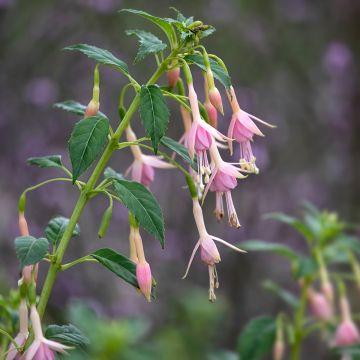
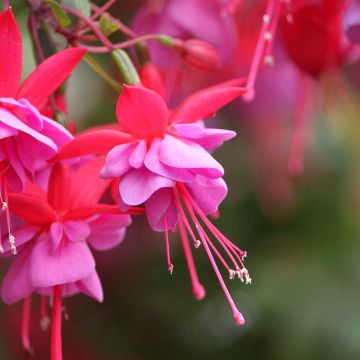


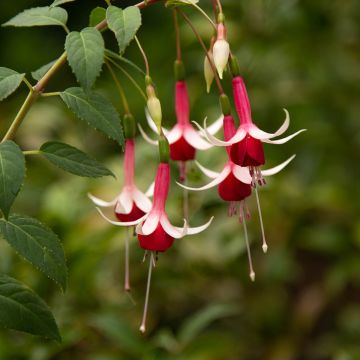
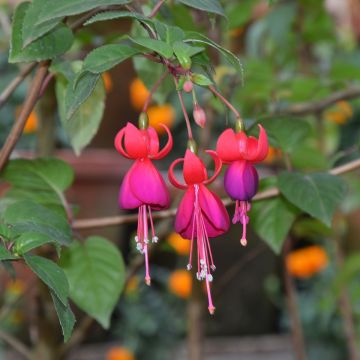
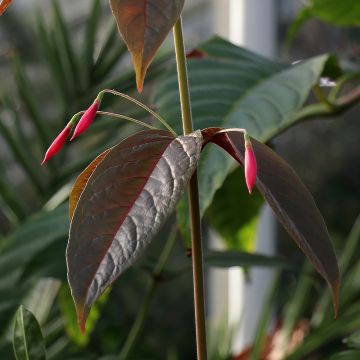
Comments